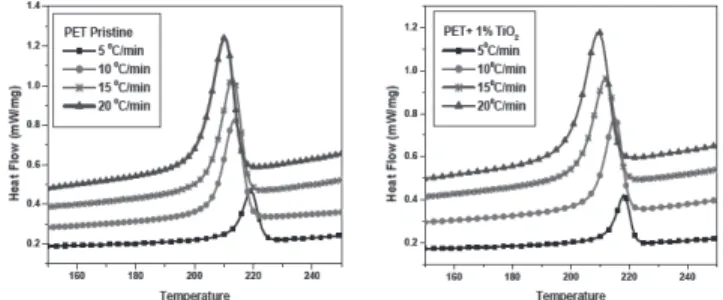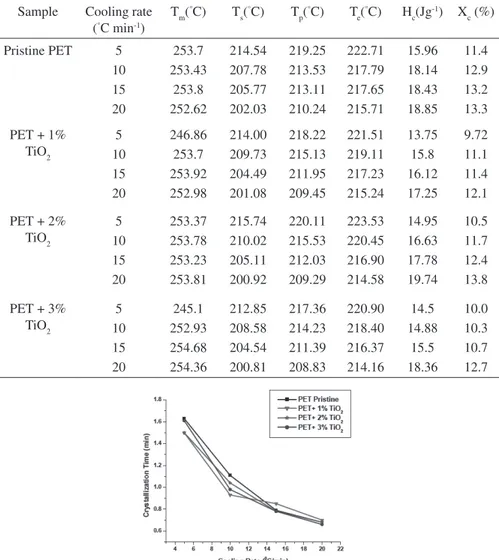Journal of Nuclear Physics, Material Sciences, Radiation and Applications Vol. 1, No. 2 February 2014 pp. 207–211
©2014 by Chitkara University. All Rights Reserved.
Synthesis and Crystallization Studies of
Thermo-plastic Polyster/Titania Nanocomposites
Harshita Agrawal1, Shalini Agarwal1, Yogendra K. Saraswat2, Kamlendra Awasthi3 and Vibhav K. Saraswat1,*
1Department of Physics, Banasthali University, Banasthali-304022, Tonk, India
2Department of Chemistry, SV (PG) College, Aligarh, UP, India
3Department of Physics, MNIT, Jaipur-302018, India
*E-mail: vibhav.spsl@gmail.com
Abstract The present work reports the non-isothermal crystallization kinetics of PET-TiO2 nanocomposites. The average particle size of TiO2 nanoparticles, prepared by chemical route, has been calculated 32 nm using Debay-Scherrer’s formula in XRD peaks. PET-TiO2 nanocomposites have been synthesized using solution casting method. The investigation of non-isothermal crystallization behavior has been conducted by means of Differential Scanning Calorimeter (DSC). The crystallization temperature shift to lower temperature for both PET pristine and PET-TiO2 nanocomposites due to decrease in mobility of chain segments and heterogeneous nucleation. Also, the inclusion of TiO2 nanoparticles may accelerate nucleation rate in nanocomposites that causes the crystallization time and absolute crystallinity fraction. The thermal conductivity of inorganic filler TiO2 nanoparticles may affect the crystallization temperature.
Keywords: XRD, DSC, crystallization temperature, polymer nanocomposites.
1. INTRODUCTION
Nowadays Polyethylene Terephthalate (PET) is considered a high consumption polymer of important commercial interest due to its wide applications as for plastic packing (e.g., beverage bottles, cosmetic containers, food, pharmaceutical packaging) [1]. PET is a slowly crystallizing polymer that can be obtained with different degrees of crystallinity (0–50%) as a result of specific thermal and/or mechanical treatment to which it is submitted [1-2]. The thermal properties of PET are used in food-packaging, peel-able seals, lids, vacuum insulation panels etc. In the packaging industry, to improve barrier performance to ultraviolet rays, as well as adding strength, stiffness, dimensional stability and heat resistance [3]. Titanium oxide (TiO2) is most commonly used inorganic filler in polymer nanocomposites. The use of TiO2 is advantageous over capping agents in the chemical reduction process of metal ions, as it is free from the blocking of active sites by organic capping agents [4]. Also the inclusion of TiO2 nanoparticles in polymer matrix, results the heterogeneous nucleation effect which provides more sites for nucleation.
Agrawal, H. Agarwal, S. Saraswat, Y.K. Awasthi, K. Saraswat, V.K.
methods were applied to describe the kinetics of the non-isothermal crystallization process of PET matrix with incorporated surface-treated TiO2 particles as well as pure nano-TiO2 particles [5]. The crystallization behavior of PET based nanocomposites containing 3 wt % of different nanoparticles (MontMorilloniTe–MMT; titanium dioxide–TiO2; and silica dioxide–SiO2) using DSC shows all fillers behave as nucleating agents for PET except SiO2 that acts as inhibitor in case of DIM procedure [1]. In the present study, we focus on the non-isothermal crystallization behavior of neat PET and PET-TiO2 nanocomposites prepared by solution casting method.
2. MATERIALS AND METHODS
Firstly, TiO2 nanoparticles have been synthesized via chemical route using TiCl3 and NH4OH solution [6]. The obtained white precipitate of TiO2 nanopowder was dried at room temperature. These TiO2 nanoparticles were added in PET solution with Dichloro methane (DCM) and Trifluoro acitic acid (TFA). Using solution casting method, the membranes of PET were prepared with different wt % of TiO2 nanoparticles (1, 2, 3 wt%). Such prepared samples were used for further study of crystallization behavior with Differential Scanning Calorimeter (DSC).
3. RESULTS AND DISCUSSION
The average grain size of TiO2 nanoparicles has been determined by X-Ray diffraction (XRD) with CuKα radiation in the range of 20-70o (λ=0.154nm) using Scherrer equation [7]
D=0.89λ/ (β cosθ) (1)
Where D is mean grain size, λ is the wavelength (Cu Kα), β is the full width at the half-
maximum (FWHM) and θ is the diffraction angle. Figure 1 shows the XRD pattern
of TiO2 nanoparicles, the average particle size of these nanoparticles was found to be
32nm.
Non-isothermal crystallization kinetics of TiO2 nanoparticle filled composites of PET has been studied using NETZSCH DSC 204 F1 Phoenix. The samples were heated up to 300 °C with different heating rates (5, 10, 15 and 20K/min)and held for
5 min to remove its previous thermal history. The crystallization behavior has been investigated by cooling these samples from 300 to 30 °C with the same cooling rate
corresponding to that particular heating rate.
Synthesis and Crystallization Studies of Thermo-plastic Polyster/Titania Nanocomposites
The overall crystallization time, tc, can be determined as followed [8]: t T T
a
c
s e
= − (2)
Where a is the cooling rate, Ts is the initial crystallization temperature, and Te is final crystallization temperature. Due to heterogeneous nucleation effect, inclusion of TiO2 nanoparticle in PET matrix may cause to reduce the overall crystallization time as well as the increment in cooling rate also results to lower tc. Figure 3 represents the overall crystallization time of PET-TiO2 nanocomposites at various cooling rates. The values of crystallization parameters have been listed in table 1.
The absolute crystallinity fraction Xc at different cooling rates can be calculated using following relation [8]:
X H
H W
c
c
f polymer
= ∆ ×
∆ 0 100 (3)
Where ∆H f
0 ~ 140 J g-1 and W
polymer is the weight fraction of the polymer matrix.
Figure 1: XRD pattern of TiO2 nanoparticles prepared by chemical method.
As listed in table 1, the degree of crystallinity has been increased by addition of TiO2 filler content. This may be explained as TiO2 nanoparticles were working as nucleation agent in PET matrix under non isothermal crystallization condition [8].
4. CONCLUSION
TiO2 nanoparticles were synthesized using chemical method and average particle size was determined 32 nm with the help of XRD. PET-TiO2 nanocomposites were prepared
Figure 3: Overall crystallization time for PET-TiO2 nanocomposites at various cooling rates.
Table 1: Crystallization parameters of PET-TiO2 nanocomposites.
Sample Cooling rate
(°C min-1)
Tm(°C) T
s(
°C) T
p(
°C) T
e(
°C) H
c(Jg -1) X
c (%)
Pristine PET 5
10 15 20 253.7 253.43 253.8 252.62 214.54 207.78 205.77 202.03 219.25 213.53 213.11 210.24 222.71 217.79 217.65 215.71 15.96 18.14 18.43 18.85 11.4 12.9 13.2 13.3
PET + 1%
TiO2 5 10 15 20 246.86 253.7 253.92 252.98 214.00 209.73 204.49 201.08 218.22 215.13 211.95 209.45 221.51 219.11 217.23 215.24 13.75 15.8 16.12 17.25 9.72 11.1 11.4 12.1
PET + 2%
TiO2 5 10 15 20 253.37 253.78 253.23 253.81 215.74 210.02 205.11 200.92 220.11 215.53 212.03 209.29 223.53 220.45 216.90 214.58 14.95 16.63 17.78 19.74 10.5 11.7 12.4 13.8
PET + 3%
Synthesis and Crystallization Studies of Thermo-plastic Polyster/Titania Nanocomposites by solution casting method and non-isothermal crystallization behavior was carried
out using DSC. The thermograms reveal that crystallization temperature shifts to lower temperature with increasing cooling rate. The nucleation and growth process causes to lower overall crystallization time and increase the absolute degree of crystallinity with inclusion of TiO2 content.
5. ACKNOWLEDGEMENT
Authors (HA, SA & VKS) are thankful to DST, Govt. of India. DST has granted sophisticated research facilities to Banasthali Vidyapith under its CURIE scheme.
REFERENCES
[1] L. V. Todorov, and J. C. Viana, Journal of Applied Polymer Science, 106, 1659–1669
(2007).
[2] J. C. Viana, N. M. Alves, and J. F. Mano, Polym Eng Sci, 44, 2174 (2004).
[3] L. V. Todorov, Multiscale morphology evolution of PET and its nanocomposites under
deformation,(Ph.D. thesis), Unversidade do Minho Escola de Engenharia (2010).
[4] S. K. Lim, S. H. Hong, S.H. Hwang, S. Kim, J. S. Han, and O. K. Kwon, Textile Research
Journal 0, (00) 1–9.
[5] X. Zhu, B. Wang, S. Chen, C. Wang, Y. Zhang, and H. Wang, Journal of Macromolecular
Science R, Part B: Physics, 47, 1117–1129 (2008).
[6] P. H. Borse, L. S. Kankate, F. Dassenoy, W. Vogel, J. Urban and S. K. Kulkarni, Journal of
material science: Materials in electronics 13, 553-559 (2002).
[7] S. Talam, S. R. Karumuri, and N. Gunnam,International Scholarly Research Network,
ISRN Nanotechnology, Article ID 372505, Volume 2012.

